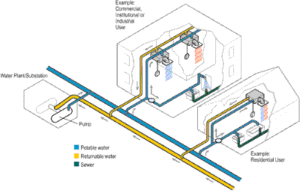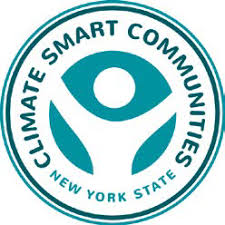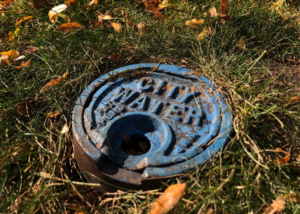Description
Geothermal District Heating/Cooling (GDHC) takes advantage of the stable temperatures below the frost line. Drawing from the latent heat in the ground enables a heat pump to provide heat to a building and depositing heat from a building into the ground enables a heat pump to cool a building. GDHC utilizes an underground pipe loop infrastructure as a shared resource in a community, similar to providing municipal water and sewer and utility natural gas delivery. Each building in the community can connect an on premise heat pump to the shared geothermal pipe loop system, thereby eliminating the need for each property owner to install their own dedicated underground pipe loop system. This reduces the upfront cost of the heating and cooling system.
The GDHC system recommended is the use of the municipal water supply. The potable water that goes through the heat exchanger of the ground source heat pump could travel back through a new return infrastructure to a town water plant for water testing and reinsertion into the water supply line. Or the water that goes through the heat exchangers could be returned into the water supply.

1
2
3
Implementation Phases
Lobby the U.S. Environmental Protection Agency to update its guidance regarding the use of potable water systems as a geothermal heat source in closed loop fashion. Simultaneously obtain federal approval or approval from the Governor’s office to conduct a feasibility study to explore deployment of water main geothermal
Investigate municipal costs to install any needed infrastructure as well as a fee structure to bill town residents for using the town water supply as the fuel-stock for their ground source heat pump in their residence
Install needed town infrastructure including flow meters to measure water flow used by heat pumps for billing purposes.
Challenges
- Current guidance from the U.S. Environmental Protection Agency regarding use of potable water systems as geothermal system energy sources needs to be overturned.
- Cost of town owned and maintained infrastructure to enable use of town water supply for heat pump use.
Example Municipalities
- In 2015 an elementary school in Valley Stream, NY was the first building in the United States to connect its geothermal system to the city water main to use the municipal water supply as a closed loop geothermal source. Doing so eliminated $600,000 in cost to drill boreholes to install a traditional geothermal system plus an additional $40,000 in reduced energy costs.
- Merrimack Valley, in northeastern Massachusetts has a proposal for the regional utility to install a pilot project shared geothermal loop system.
Greenhouse Gas (GHG) Reductions
Data not available.

Climate Smart Communities (CSC) & Clean Energy Communities (CEC) Link
This action is also related to several CSC and CEC actions for which you can get points toward certification…
CSC Actions:
CEC Actions:

Co-benefits
There are multiple co-benefits to completing this action, including:
- Benefits?
Resources
List resources here.
And here too.



